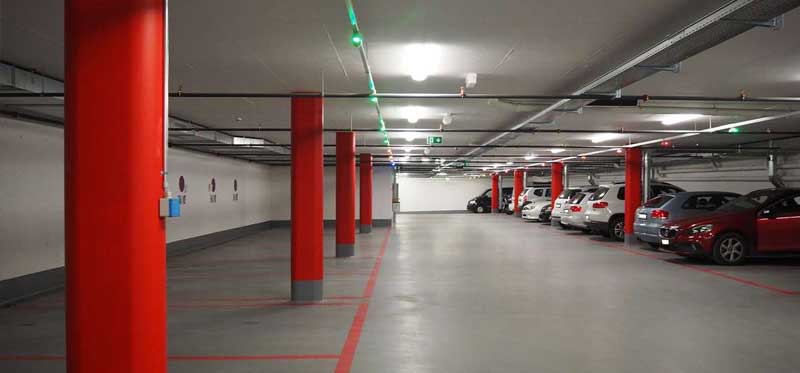Smart parking is a wide concept that includes different levels intelligent solutions, but it is based on a parking spaces that has vehicle detection sensors and cameras with automated vehicle license recognition, for example, that collect data to help users find a free parking space more quickly, as well as smart meters or smart payment.
According to a Smart Parking Institute survey, 42% of respondents voted in favor of the necessity of parking systems. The good news is, thanks to a parking lot sensor system, connected platforms, and other IoT applications, drivers can find out where the nearest parking spot is located, if it's occupied. In the future, real-time parking maps will likely be commonplace.

IoT is the technology at the core of vehicle tracking platforms. Tools like GPS or OBD sensors help collect location data on a car or a fleet and monitor the occupancy of parking spaces. This information is transferred to the cloud gateway, processed and sent to the network server. The data will be presented to drivers and car company managers in the form of understandable, clear insights.
As for now, IoT-based vehicle trackers are mainly used by large-scale corporate organizations for fleet management. In the future, when the release of 5G makes the Internet of Things more accessible, parking lot technology will spread among car drivers and will be used to manage daily commutes and mitigate parking challenges.
A connected counting system can detect when a vehicle enters and leaves the parking facility. This way, IoT-based platforms will be able to offer drivers a real-time counter of available spots.
Facility managers can use counter systems to increase the efficiency of the parking facility, determine trends and patterns regarding the customer flow, and be able to predict future vehicle surges.
Ultrasonic:
An ultrasonic transducer emits an ultrasonic wave (sound at a frequency higher than a human ear can hear) and receives reflections from nearby objects. Exactly as in Doppler radar, heterodyne detection of the received field indicates motion. The detected doppler shift is also at low audio frequencies (for walking speeds) since the ultrasonic wavelength of around a centimeter is similar to the wavelengths used in microwave motion detectors. One potential drawback of ultrasonic sensors is that the sensor can be sensitive to motion in areas where coverage is undesired, for instance, due to reflections of sound waves around corners. Such extended coverage may be desirable for lighting control, where the goal is the detection of any occupancy in an area. But for opening an automatic door, for example, a sensor selective to traffic in the path toward the door is superior.
Car Defenders! Corner Protectors, Wall Guards, Curbs and Bumps
Small additions that help keep your car and property looking newBuying a new car? Before you bring a new vehicle home, consider: how are you going to feel about the dents and dings coming to your brand-new paint job? Some people don't know until they first see the scrape in their paint, but others want to get in front of the issue. Corner guards and wall protectors are one cost-effective way to protect vehicles in the home garage where they spend much of their time.
For site planners working with multi-vehicle parking garages, corner and wall guards are minor investment with two dividends. Thinking ahead to where drivers might find parking a tight squeeze allows planners to create safety and ease for users. It also protects the corners of the structure itself.
Corner guards are not just handy for the protection of vehicles. They can help protect property as well. In commercial parking lots, corner guards for walls and structural pillars can prevent cars from chipping the corners, keeping the structure looking new and well cared for.
Drivers coming into well-tended spaces feel more confident about their destination, and about leaving their car behind. Even though a car rubbing against a support is not going to do structural damage, the cosmetic damage it can leave makes a parking structure look and feel more worn than it actually is.
As cars grow bigger, some drivers find parking structures more challenging to negotiate. An older garage with smaller spaces might moderate this frustration by providing protection on support structures. Drivers of larger cars can be confident that they won't end up with scratches. They may even leave more room between themselves and the car beside them, knowing that the door closer to the pillar won't be dinged on opening.
IoT is the technology at the core of vehicle tracking platforms. Tools like GPS or OBD sensors help collect location data on a car or a fleet and monitor the occupancy of parking spaces. This information is transferred to the cloud gateway, processed and sent to the network server. The data will be presented to drivers and car company managers in the form of understandable, clear insights.
As for now, IoT-based vehicle trackers are mainly used by large-scale corporate organizations for fleet management. In the future, when the release of 5G makes the Internet of Things more accessible, parking lot technology will spread among car drivers and will be used to manage daily commutes and mitigate parking challenges.
See also:
Did you find what you need?
If not, please let us know what you were trying to find. Feedback from you will help us improve our website.
Contact us
Security saving tips
- You are a target to intruders
- Keep system up-to-date
- Place CCTV cameras to monitor hidden entry points
- Protect or hide your cables
- Connect Securely
- Back up your data
-
 Fast Callback and response
Fast Callback and response
-
 Dedicate Help center
Dedicate Help center
-
 Professional diagnose
Professional diagnose
-
 Delivery on time
Delivery on time
